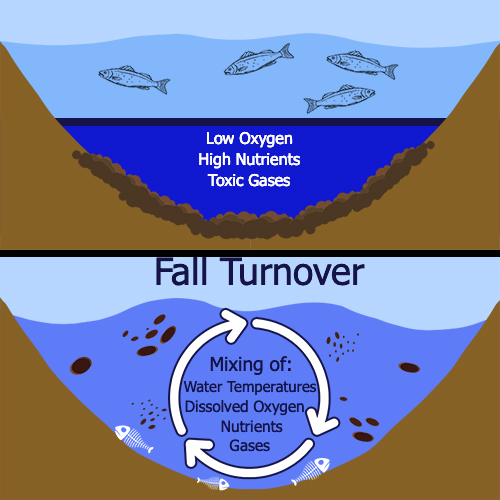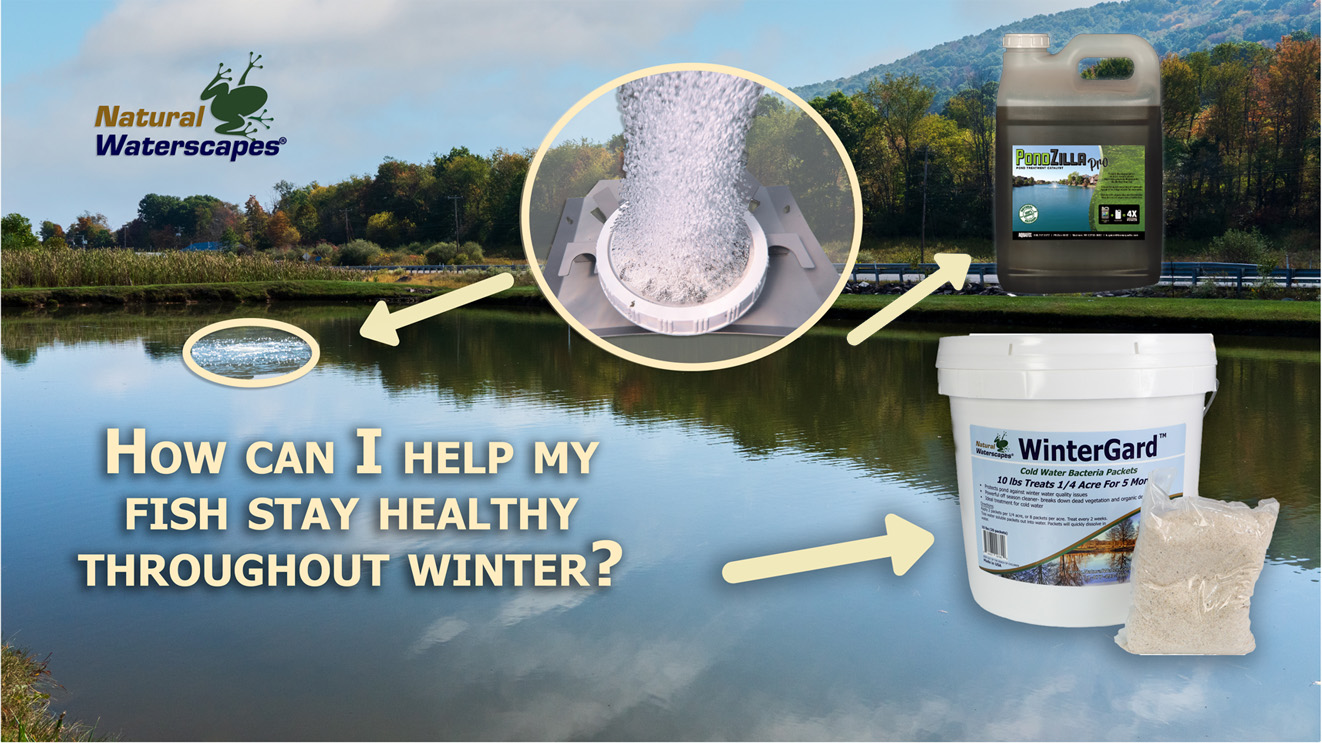Fall Pond Turnover & Seasonal Water Quality Changes
As the days shorten and air temperatures decline, your pond undergoes some dramatic internal changes. These shifts don’t just affect aesthetics — they impact dissolved oxygen levels, nutrient cycling, fish health, and the risk of seasonal “fish kills.” Ignoring these changes is one of the most common mistakes pond owners make. Below is a more in-depth guide to what’s happening — and how you can proactively manage it.
The Seasonal Shift: What happens in Autumn
Vegetation Dieback and Leaf Drop
- Aquatic plants, both floating and submerged, as well as algae begin to die back
- Free-floating plants like duckweed and watermeal sink and settle to the bottom
- Shoreline vegetation, leaves from the trees and pine needles all accumulate along pond edges
Decomposition, Oxygen Demand & Nutrient Release
- Dying vegetation decomposes, converting to organic muck overtime
- During decomposition, nutrients (nitrogen, phosphorus) are released back into the water column. These are the same nutrients that fuel algae growth
- In the process of breakdown of debris, there is an increased demand for oxygen. It is consumed by natural bacteria during the decomposition process
Planktonic Algae Crash & Improved Clarity
- Algae populations oftenn decline in cooler, lower-light conditions, leading to clearer water
- When algae cells die they dump the stored nutrients back into the water, adding to overall nutrient levels
Pond Stratification & Fall Turnover: Why It's Dangerous
What is Stratification?
Stratification is the separation of pond or lake water into layers. Warm, oxygen-rich water is at the top. This is called the epilimnion. Cooler water, which is lower in oxygen is at the bottom. This is called hypolimnion.
This separation of water occurs because of the density differences. Water is most dense at approximately 39 degrees F. Because water layers of different temperatures don’t easily mix, water ends up forming distinct layers.
What Causes Stratification to Break (Turnover)
As autumn arrives, surface water cools, becoming denser. Eventually, it matches the density of the deeper water, allowing full mixing.
This turnover equalizes temperature and oxygen — but also stirs up all the low-oxygen, nutrient-rich water from the bottom. That’s why fall is both a reset opportunity and a risk period if you’re unprepared.
Risks During Turnover
Oxygen Crash: The mixing can sharply drop dissolved oxygen levels throughout the water column, potentially creating hypoxic (low-oxygen) zones. Fish and other aerobic organisms can suffocate if they can’t escape to oxygenated regions.
Nutrient Surge: The surge of phosphorus and nitrogen releases upward from nutrient-rich bottom muck.
Fish Shock: Sudden changes in temperature, oxygen, and chemical composition can stress fish, sometimes causing fish kills.

Mitigating The Risk Of Pond Turnover: Best Management Practices
Stay ahead of seasonal threats rather than reacting after the damage is done.
Aeration
Bottom aeration helps prevent strong stratification by mixing bottom water upward over time. This evens out oxygen distribution and reduces the shock of turnover. Operate aeration system 24/7 through autumn and early winter. Alternatively, surface aeration can be ultilized in bodies of water 8 feet deep or less.
Fix Poor Water Quality
Take active steps to prevent a surge of nutrients in water. Continue to apply beneficial bacteria and phosphate binders in fall and winter.
Not all bacterial pond products remain active in cold water; many slow or stop below 40–50 °F. That’s where cold-water formulations come in, tailored to thrive in cooler environments.
WinterGard is a blend of beneficial bacteria in water soluble packets designed to breaking down ammonia, nitrate, and nitrite in cold water (34–60 °F)
Muck Remover Fall/Winter Blend is a newer addition specifically formulated for organic sludge reduction during colder months (34–60 °F)
Phosphate Eliminator has no water temperature limitations! Continue use of Phosphate Eliminator to reduce phosphate in water.
Monitor Water Quality
It is important to test water quality in fall. Determine if there are specific issues heading into cold months that need addressed. Knowledge is your greatest ally. Correcting issues in the fall/winter keeps fish healthier and reduces problems when water warms in the spring. Get your water tested!

